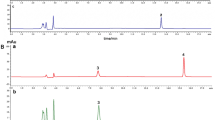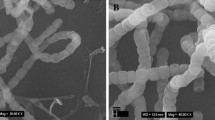Abstract
A Gram-negative anaerobic microorganism, MRG-1, isolated from human intestine showed high activities of deglycosylation and reduction of daidzin, based on rapid TLC analysis. A rod-shaped strain MRG-1was identified as a new species showing 91.0% homology to Coprobacillus species, based on 16S rRNA sequence analysis. The strain MRG-1 showed β-glucosidase activity toward daidzin and genistin, and daidzein and genistein were produced, respectively. However, the strain MRG-1 did not react with flavone glycosides, flavanone glycosides, and isoflavone C-glucoside. Besides, MRG-1 showed stereoselective reductase activity to isoflavone, daidzein, genistein, 7-hydroxyisoflavone, and formononetin, resulting in the formation of corresponding R-isoflavanone enantiomers. The new isoflavanones of 7-hydroxyisoflavanone and dihydroformononetin were characterized by NMR, and the absolute configurations of the enantiomers were determined with CD spectroscopy. The kinetic study of the anaerobic biotransformation showed both activities were exceptionally fast compared to the reported conversion by other anaerobic bacteria.





Similar content being viewed by others
References
Chen L-H, Fang J, Li H, Demark-Wahnefried W, Lin X (2007) Enterolactone induces apoptosis in human prostate carcinoma LNCaP cells via a mitochondrial-mediated, caspase-dependent pathway. Mol Cancer Ther 6:2581–2590
Chun J, Lee JH, Jung Y, Kim M, Kim S, Kim BK, Lim YM (2007) EzTaxon: a web based tool for the identification of prokaryotes based on 16S ribosomal RNA gene sequences. Int J Syst Evol Microbiol 57:2259–2261
Du H, Huang Y, Tang Y (2010) Genetic and metabolic engineering of isoflavonoid biosynthesis. Appl Microbial Biotechnol 86:1293–1312
Felsenstein J (1985) Confidence limits on phylogenies: an approach using the bootstrap. Evolution 39:783–791
Hedlund TE, Johannes WU, Miller GJ (2003) Soy isoflavonoid equol modulates the growth of benign and malignant prostatic epithelial cells in vitro. Prostate 54:68–78
Hur HG, Lay JO Jr, Beger RD, Freeman JP, Rafii F (2000) Isolation of human intestinal bacteria metabolizing the natural isoflavone glycosides daidzin and genistin. Arch Microbiol 174:422–428
Hwang CS, Kwak HS, Lim HJ, Lee SH, Kang YS, Choe TB, Hur HG, Han KO (2006) Isoflavone metabolites and their in vitro dual functions: they can act as an estrogenic agonist or antagonist depending on the estrogen concentration. J Steroid Biochem Mol Biol 101:246–253
Jiang JR, Yuan S, Ding JF, Zhu SC, Xu HD, Chen T, Cong XD, Xu WP, Ye H, Dai YJ (2008) Conversion of puerarin into its 7-O-glycoside derivatives by Microbacterium oxydans (CGMCC 1788) to improve its water solubility and pharmacokinetic properties. Appl Microbial Biotechnol 81:647–657
Jin J-S, Zhao Y-F, Nakamura N, Akao T, Kakiuchi N, Min B-S, Hattori M (2007) Enantioselective dehydroxylation of enterodiol and enterolactone precursors by human intestinal bacteria. Biol Pharm Bull 30:2113–2119
Kageyama A, Benno Y (2000) Coprobacillus catenaformis gen. nov., sp. nov., a new genus and species isolated from human feces. Microbiol Immunol 44:23–28
Kim M, Han J, Kim S-U (2008) Isoflavone daidzein: chemistry and bacterial metabolism. J Appl Biol Chem 51:253–261
Kim M, Kim S-I, Han J, Wang X-L, Song D-G, Kim S-U (2009) Stereospecific biotransformation of dihydrodaidzein into (3S)-equol by the human intestinal bacterium Eggerthella strain Julong 732. Appl Environ Microbiol 75:3062–3068
Kim M, Marsh ENG, Kim S-U, Han J (2010a) Conversion of (3S,4R)-tetrahydrodaidzein to (3S)-equol by THD reductase: proposed mechanism involving a radical intermediate. Biochemistry 49:5582–5587
Kim M, Won D, Han J (2010b) Absolute configuration determination of isoflavan-4-ol stereoisomers. Bioorg Med Chem Lett 20:4337–4341
Lampe JW, Karr SC, Hutchins AM, Slavin JL (1998) Urinary equol excretion with a soy challenge: influence of habitual diet. Proc Soc Exp Biol Med 217:335–339
Laparra JM, Sanz Y (2010) Interactions of gut microbiota with functional food components and nutraceuticals. Pharmacol Res 61:219–225
Larrosa M, González-Sarrías A, García-Conesa MT, Tomás-Barberán FA, Espín JC (2006) Urolithins, ellagic acid-derived metabolites produced by human colonic microflora, exhibit estrogenic and antiestrogenic activities. J Agric Food Chem 54:1611–1620
Lee HP, Gourley L, Duffy SW, Estve J, Lee J, Day NE (1991) Dietary effects on breast-cancer risk in Singapore. Lancet 337:1197–1200
Lund TD, Munson DJ, Haldy ME, Setchell KDR, Ed L, Handa RJ (2004) Equol is a novel anti-androgen that inhibits prostate growth and hormone feedback. Biol Reprod 70:1188–1195
Miyase T, Sano M, Nakai H, Muraoka M, Nakazawa M, Suzuki M, Yoshino K, Nishihara Y, Tanai J (1999) Antioxidants from Lespedeza homoloba (I). Phytochemistry 52:303–310
Muthyala RS, Ju YH, Sheng S, Williams LD, Doerge DR, Katzenellenbogen BS, Helferich WG, Katzenellenbogen JA (2004) Equol, a natural estrogenic metabolite from soy isoflavones: convenient preparation and resolution of R- and S-equols and their differing binding and biological activity through estrogen receptors alpha and beta. Bioorg Med Chem 12:1559–1567
Raimondi S, Rongcaglia L, Lucia MD, Amaretti A, Leonardi A, Pagnoni UM, Rossi M (2009) Bioconversion of soy isoflavones daidzin and daidzein by Bifidobacterium strains. Appl Microbial Biotechnol 81:943–950
Saitou N, Nei M (1987) The neighbor-joining method: a new method for reconstructing phylogenetic trees. Mol Biol Evol 4:406–425
Seo J, Kang S-I, Kim M, Won D, Takahashi H, Ahn JH, Chong Y, Lee E, Lim Y, Kanaly RA, Han J, Hur HG (2010a) Time-dependent density functional theory-assisted absolute configuration determination of cis-dihydrodiol metabolite produced from isoflavone by biphenyl dioxygenase. Anal Biochem 397:29–36
Seo J, Kang S, Ryu J-Y, Lee Y-J, Park KDK, Mihyang WD, Park H-Y, Ahn JH, Chong Y, Kanaly RA, Han J, Hur HG (2010b) Location of flavone B-ring controls regioselectivity and stereoselectivity of naphthalene dioxygenase from Pseudomonas sp. strain NCIB 9816-4. Appl Microbiol Biotechnol 86:1451–1462
Seo J, Kang S-I, Won D, Kim M, Ryu J-Y, Kang S-W, Um B-H, Pan C-H, Ahn J-H, Chong Y, Kanaly RA, Han J, Hur H-G (2011) Absolute configuration-dependent epoxide formation from isoflavan-4-ol stereoisomers by biphenyl dioxygenase of Pseudomonas pseudoalcaligenes strain KF707. Appl Microbiol Biotechnol 87 (in press)
Tamura M, Tsushida T, Shinohara K (2007) Isolation of an isoflavone-metabolizing, Clostridium-like bacterium, strain TM-40, from human faeces. Anaerobe 13:32–35
Van Duynhoven J, Vaughan EE, Jacobs DM, Kemperman RA, van Velzen EJJ, Gross G, Roger LC, Possemiers S, Smilde AK, Doré J, Westerhuis JA, de Wiele TV (2010) Metabloic fate of polyphenols in the human superorganism. Proc Natl Acad Sci USA 107 (in press)
Wang X-L, Shin K-H, Hur H-G, Kim S-I (2005) Enhanced biosynthesis of dihydrodaidzein and dihydrogenistein by newly isolated bovine rumen anaerobic bacterium. J Biotech 115:261–269
Won D, Shin B-K, Han J (2008) Synthesis and the absolute configurations of isoflavanone enantiomers. J Appl Biol Chem 51:17–19
Acknowledgements
The authors thank Ms. Jae Eun Hwang for her excellent NMR measurements. This work was supported by the National Research Foundation of Korea (NRF) grant funded by the Korea government (MEST) (No. 331-2008-1-F00014).
Author information
Authors and Affiliations
Corresponding author
Electronic supplementary materials
Below is the link to the electronic supplementary material.
ESM 1
(DOC 366 kb)
Rights and permissions
About this article
Cite this article
Park, HY., Kim, M. & Han, J. Stereospecific microbial production of isoflavanones from isoflavones and isoflavone glucosides. Appl Microbiol Biotechnol 91, 1173–1181 (2011). https://doi.org/10.1007/s00253-011-3310-7
Received:
Revised:
Accepted:
Published:
Issue Date:
DOI: https://doi.org/10.1007/s00253-011-3310-7




